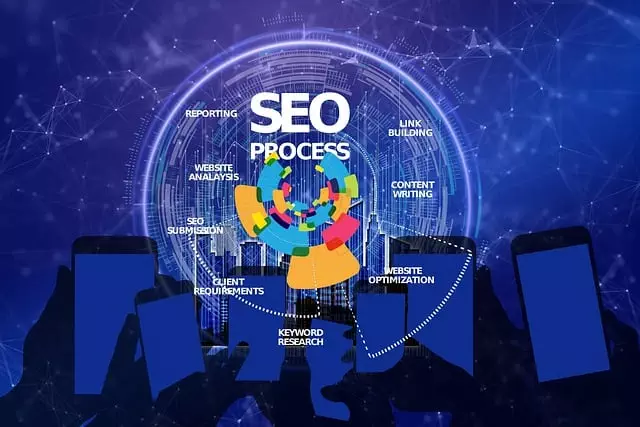Semantic SEO optimizes content for search engines by focusing on user intent, context, and meaning. Key techniques include refining schema markup for structured data, creating descriptive URLs, implementing internal linking, and optimizing meta tags. Keyword research reveals relevant terms and long-tail keywords, guiding content creation to meet search engine expectations. Advanced NLP algorithms in semantic navigation enhance site structure and user experience, improving rankings through accurate indexing and rich snippets. Building high-quality backlinks with semantic anchor text boosts authority and relevance. Measuring success involves analyzing engagement metrics beyond keyword rankings, ensuring content aligns with user intent. With AI advancements, marketers must adapt Technical SEO Techniques for semantic optimization to stay competitive while enhancing user connections.
“Unleash the power of Semantic SEO to elevate your website’s visibility and search engine rankings. In today’s competitive digital landscape, understanding semantic signals is paramount for online success. This comprehensive guide delves into the intricacies of Technical SEO techniques optimized for content relevance. From keyword research to on-page optimization, structured data utilization, and beyond, each aspect contributes to a seamless user experience. Master these strategies to stay ahead, ensuring your website not only ranks higher but also captivates your audience.”
Understanding Semantic SEO and Its Impact on Search Engine Rankings

Semantic SEO is a powerful strategy that focuses on enhancing the search engine understanding of your content by aligning it with user intent and the context of their queries. It involves using technical SEO techniques to ensure search engines accurately interpret the meaning behind words, phrases, and topics. By masterfully employing semantic optimization, websites can significantly improve their search rankings and attract more relevant traffic.
This approach delves into the essence of how users communicate with search engines, aiming to provide answers rather than just keywords. It encourages content creators to think beyond individual terms and consider the broader concept or topic being searched. As a result, search engine algorithms can better index and rank pages, leading to higher visibility for sites that offer valuable, contextually relevant information.
Technical SEO Techniques for Optimizing Content Relevance

In the realm of Semantic SEO Mastery, Technical SEO Techniques play a pivotal role in enhancing content relevance. These techniques ensure that search engines can accurately interpret and understand the context and meaning behind words on a webpage. One key method is optimizing schema markup, which provides structured data to search engines, helping them grasp the essence of your content. Additionally, URL structure refinement involves creating clean, descriptive URLs that mirror the page’s content, making it easier for both users and search algorithms to navigate.
Further, implementing internal linking strategies ensures that related pages within your site connect seamlessly. This not only improves user experience but also signals to search engines which topics are most relevant. Additionally, optimizing meta tags—including titles and descriptions—with targeted keywords and compelling copy can significantly boost content visibility. These Technical SEO Techniques collectively work to make your content more accessible and meaningful for both users and search engine crawlers.
Keyword Research: Identifying Semantically Related Terms

Keyword research is a crucial aspect of Semantic SEO, where identifying semantically related terms involves understanding how users search and the context behind their queries. This process requires delving into tools and techniques to uncover relevant keywords that aren’t just about exact matches but also about capturing the semantic essence of user intent.
Technical SEO techniques play a significant role here by enabling you to analyze search patterns, identify long-tail keywords, and understand synonyms or related terms that users might employ when searching for your content. This strategic approach ensures your website resonates with search engines and provides value to visitors, ultimately improving rankings and driving organic traffic.
On-Page Optimization: Implementing Semantic Markup and Schema

Semantic SEO involves enhancing your website’s content so search engines can better understand its meaning, context, and intent. One crucial aspect of this strategy is on-page optimization, particularly through implementing semantic markup and schema. These Technical SEO techniques enable search engines to interpret your web pages accurately, thereby improving their visibility in relevant searches.
Schema markup provides structured data that highlights key information about your content—from events and reviews to products and recipes. This structured format helps search engines like Google better index and display your content in rich snippets, attracting more clicks and potentially boosting your rankings. By incorporating schema appropriately, you make your web pages more engaging and valuable to both users and search engine crawlers.
Enhancing User Experience with Semantic Navigation

Semantic navigation is a powerful technique that enhances user experience by understanding their intent and providing relevant content. It goes beyond traditional keyword-based navigation, leveraging advanced Natural Language Processing (NLP) algorithms to interpret user queries more accurately. By analyzing the context, semantical search enables websites to deliver precise results, ensuring visitors find what they’re looking for swiftly.
This approach is particularly beneficial for Technical SEO Techniques as it improves site structure and internal linking. Semantic navigation helps organize content in a hierarchical manner, making it easier for search engines to crawl and index pages. Moreover, it reduces bounce rates and increases engagement by offering users a more intuitive and personalized experience, ultimately leading to better search rankings and higher user satisfaction.
Leveraging Structured Data for Rich Snippets and Knowledge Graphs

Structured data is a powerful tool in the arsenal of any SEO expert, enabling search engines to understand content at a deeper level. By implementing this Technical SEO technique, websites can enhance their visibility and provide more relevant results for users. It allows webmasters to mark up specific pieces of information within their HTML code, creating structured, machine-readable data. This is where the magic happens; search engines like Google can then extract and display key details in rich snippets or even incorporate them into the Knowledge Graph.
For example, when a restaurant’s menu is marked up with structured data, Google might show the dish names, prices, and reviews directly in the search results page. This not only improves user experience but also increases the likelihood of clicks and higher rankings. Structured Data is a game-changer when it comes to standing out in a competitive online landscape, ensuring your website provides valuable insights at a glance.
Building High-Quality Backlinks with Semantic Anchor Text

In the realm of Technical SEO Techniques, building high-quality backlinks with semantic anchor text is a strategic art. These backlinks, which point to your website from authoritative sources, carry significant weight in search engine rankings. The power lies in using relevant, contextually meaningful keywords as anchor text, aligning perfectly with the content on your site. This approach ensures that the link’s value is accurately reflected by search engines, boosting your site’s authority and relevance for specific queries.
Instead of generic anchors, focus on semantic variations that capture the essence of your content. For instance, if you’re optimizing for a phrase like “effective content marketing strategies,” use backlinks with anchor text such as “innovative content creation techniques” or “top digital marketing trends.” This technique not only strengthens your site’s SEO but also fosters a natural and diverse backlink profile, a key factor in search engine algorithms.
Measuring Success: Analyzing Semantic SEO Performance Metrics

Measuring success in Semantic SEO involves delving into specific performance metrics that showcase how effectively your website aligns with search engine algorithms focusing on semantic understanding. These metrics go beyond traditional keyword rankings, exploring factors like query intent, topic relevance, and user engagement. By utilizing Technical SEO techniques to optimize content for semantic accuracy, you can enhance the visibility of your pages in search results.
Analyzing these metrics helps identify areas where your Semantic SEO strategies are thriving and spots that need improvement. For instance, monitoring click-through rates (CTRs) reveals how well your content satisfies user queries, while time spent on page and bounce rate offer insights into the quality and relevance of your content. Keep in mind that successful Semantic SEO is not just about ranking higher; it’s about ensuring your website provides valuable, contextually relevant information that resonates with users’ search intentions.
Future Trends in Semantic SEO and Continuous Optimization

As we move forward, the landscape of Semantic SEO is ever-evolving, driven by advancements in artificial intelligence and natural language processing. Future trends suggest a greater emphasis on contextual understanding, where search engines will not only interpret keywords but also grasp the intent behind them. This shift demands that marketers embrace more sophisticated Technical SEO Techniques to optimize content for semantic relevance. By leveraging structured data markup, entity recognition, and enhancing topic clustering, businesses can ensure their websites provide accurate answers to user queries.
Continuous optimization is key to staying ahead in this dynamic space. Regularly updating content to reflect the latest industry developments, monitoring competitor strategies, and adapting to algorithm updates are essential practices. Moreover, engaging in thorough keyword research and incorporating long-tail keywords can further improve semantic search rankings. These efforts collectively contribute to a more seamless user experience, fostering stronger connections between brands and their target audiences.
